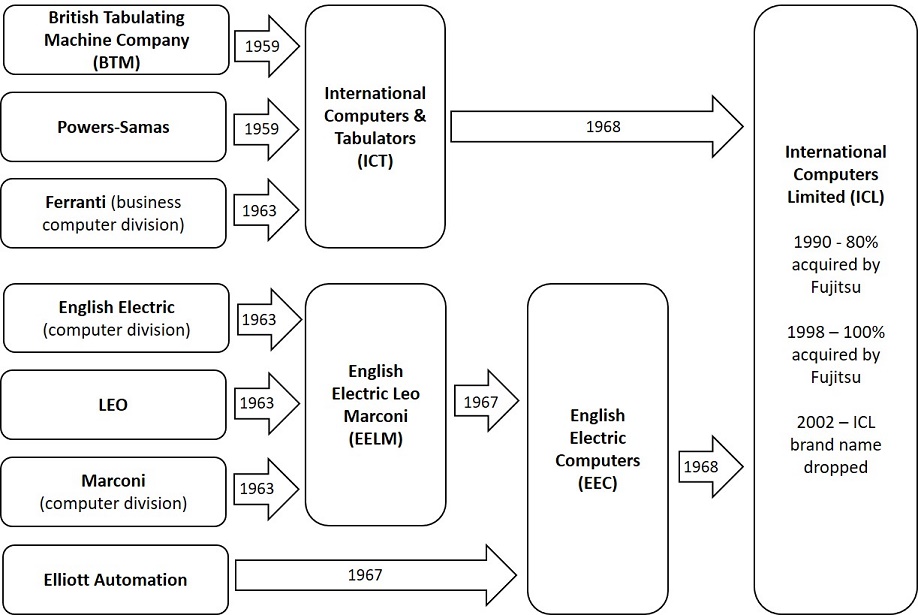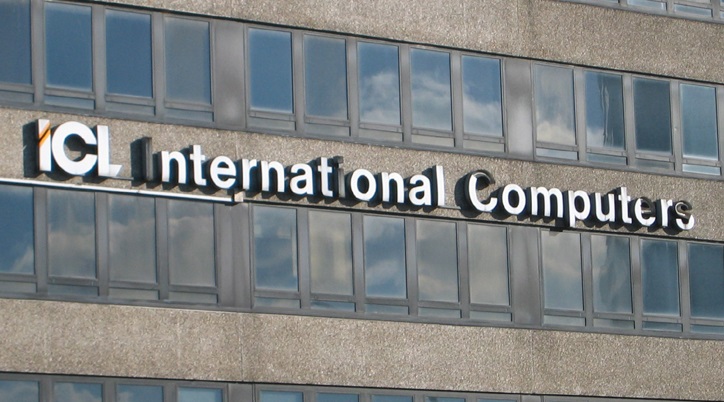Preamble
The Australian Computer Society (ACS) was formed 50 years ago, when the various state computer societies joined forces.
To mark the occasion, the ACS has initiated a heritage project to honour the many individuals who have contributed to the growth of the ICT profession in Australia.
At the heart of the project is a history of computing in Australia. It is not just a history of the ACS, but the history of a profession.
Australia has the longest computing history of any country, excepting the US and the UK, and CSIRAC in the Museum of Victoria is the oldest computer still in existence.
Chapter 27: ICL
IBM and the BUNCH, examined in previous chapters, were all US suppliers. Also active in Australia were a number of other mainframe players that made the country the most competitive market in the world for these large computers in their heyday.
The BUNCH acronym was coined in the USA, and referred only to US computer companies. If it were applied worldwide, it would have had to squeeze in an ‘I’, because British mainframe supplier ICL shared many of the characteristics of the BUNCH.
ICL (International Computers Limited) was formed in 1968 with the merger of British computer companies ICT (International Computers and Tabulators) and EEC (English Electric Computers). EEC had been formed from a merger of Elliott Automation and EELM in 1967. EELM was the result of an earlier merger, between English Electric, LEO, and Marconi (see chart).
The creation of ICL was a policy decision by Harold Wilson’s UK Labour Government, elected in 1964 after 13 years of Conservative rule. In 1968 it passed the Industrial Expansion Act as a means of rationalising and strengthening Britain’s industrial sector.
The Government took a 10.5 percent stake in the company, for which it provided £10 million in funding for R&D. The rest was held by English Electric and electronics company Plessey (18 percent each), with the majority (53.5 percent) owned by the former shareholders of ICT.
ICL was initially successful, but only because British government agencies were forced to buy its products. In its first year of operation it gained 97.6 percent of the government’s computer orders. That dropped to virtually zero after Edward (Ted) Heath’s Conservative government, elected in 1970, opened the government market to competitive tendering.
The Tories repealed the Industrial Expansion Act, but were forced to lend ICL £40 million in 1971 to keep it going during the recession of that year. The money was used to develop a new range of computers called the 2900 series. These were very successful and the company’s problems appeared to be over – but not for long.
ICL in Australia
Australia, ICL’s most successful international subsidiary, was formed in 1968 with the merger of the local distributor of EEC and the Australian operation of ICT.
EEC’s Australian distributor was Australian Computers, usually called AusComp,. It was owned 60 percent by English Electric Computers and 40 percent by Australian electrical and electronics company AWA. It had planned to produce the EEC System/4 computer in Australia, but nothing had come of the idea before ICL was formed in 1968.
The various companies that formed ICL had all sold machines in Australia, so when ICL came into existence it had a large local user base. Two of Australia’s first four computers were from companies that came to be part of ICL – the University of NSW’s UTECOM was from Elliott and WREDAC at the Weapons Research Establishment in South Australia was an English Electric machine.
The Australian operation of ICT had been very successful, selling hundreds of computers in Australia in the 1960s. Before the introduction of the ICT 1900 in the mid-1960s, most of these machines were rebadged Sperry Univac 1004s, a comparatively inexpensive machine introduced in 1962 and programmed by a plug board.
They were replaced by the much more advanced 1900s, which were based on the Ferranti Packard FP6000, developed by the Canadian subsidiary of Ferranti before the formation of ICT in 1963.
The 1900 was released in 1964, and was similar to the IBM System/360 in that it was a family of computers with a consistent architecture from the smallest to the largest machine. It was announced six months after IBM’s architecture, but deliveries in Australia started shortly afterwards, before any IBM System/360s came to Australia.
From the English Electric side of ICL came the System/4, an IBM System/360 compatible machine. The System/4 was licenced from US mainframe company RCA, which called it the Spectra 70 (RCA left the IT industry in 1971 and its user base was acquired by Sperry).
Both architectures were successful in Australia. A 1900 replaced an IBM S/360 at Woolworths and the Customs Department installed a high-end Model 4/72 in 1972. Another System/4 replaced an IBM S/360 at pharmaceuticals distributor DHA.

ICL family tree
Queensland success
ICL was remarkably successful in Queensland, largely through the efforts of one man, sales manager John Marshall. He had worked for Powers-Samas in the 1950s, and stayed with the company as it morphed into ICT and ICL.
Marshall had been very successful selling Powers-Samas punch card machines around Queensland. When the organisations transitioned to electronic computers, he was able to keep all these customers in the ICT/ICL camp. When the ICL 1900 was released, he sold dozens of machines to virtually every major computer user in the state, in the private and public sector. The only exception was Queensland Railways, which went with IBM.
ICL sold a 1903A to the South Australian Institute of Technology in 1970, and was persuaded by the South Australian Government to establish a software development centre in Adelaide. It became the largest software laboratory in Australia, employing 60 people, but it was closed in 1974 because of ‘communication problems’ with head office in London.
Staff were offered fully paid transfers to ICL in the United Kingdom, but many stayed in Australia with their expertise forming the genesis of the Adelaide Technology Park.
The 2900 series mainframes were announced in 1974 and became available in Australia the following year. They were advanced machines able to emulate software from both the architectures inherited in the merger. The low end 2903 model in particular was a great success in Australia.
In 1976 ICL acquired minicomputer supplier Singer Business Machines. The Singer System Ten, which had nearly 100 Australian users, was developed into the ICL System 25 minicomputer, which formed the basis of ICL Australia’s move into the retail vertical market in the 1980s.
The struggles begin
ICL started to struggle in the late 1970s. In 1981, US mainframe company Univac attempted to buy it (there had also been discussions with Burroughs in 1973). A loan guarantee from the British Government saw off that challenge, but ICL started looking for global partnerships that would enable it to stay in the race technologically and financially. After the Univac scare, ICL cancelled its expensive chip development program and bought its semiconductor technology from Fujitsu.
In 1984 ICL was acquired by major British telecommunications company STC (Standard Telephones and Cables). Things did not go well, and ended up with ICL bailing out STC when that company suffered financial problems. Within a few years ICL was contributing 60 percent of STC’s total revenues. ICL’s combative new CEO Peter Bonfield turned the combined operation around, but the competitive pressures continued to mount.
The company, despite many acquisitions, further investment from the British Government and substantial product development, was never able to compete against IBM and the other mainframe players. The Series 39, the first mainframe computer to use optical fibres (five years before IBM), was released in 1985. It was an impressive machine, but it was too late.
Fujitsu ended up making more and more of the internal componentry of ICL’s mainframes, and in 1990 acquired 80 percent of the company. Two years later it acquired the rest, and ICL became wholly owned by Fujitsu.
The ICL brand was quietly dropped as the company was merged into Fujitsu over the next few years. The dream of a British computer giant was over. ICL Australia, like the parent company, disappeared into Fujitsu – which we shall examine next week.
Veteran ICT journalist Graeme Philipson is researching and writing the Heritage Project book, which is due for release on the 50th anniversary of the formal incorporation of the ACS, on 3 October 2017.
The project also involves the creation of a ‘virtual museum’, cataloguing hardware and other artefacts, and collecting and curating documents on the history of the industry, including oral histories of as many people as possible.
Please get in touch with Graeme if you would like to contribute, at [email protected]
Do you have early memories of the ICT industry in Australia? Help us make history by sending us your story! Record or write your memories to be included in our historic ACS Heritage Project. Details here.
Previously published:
Chapter 26: The rest of the BUNCH
Chapter 25: Honeywell in Australia
Chapter 23: ACS at home and abroad
Chapter 22: The early years of the Australian Computer Society
Chapter 21: Other Australian universities
Chapter 20: University of Melbourne and Monash
Chapter 19: Sydney University and UNSW lead the way
Chapter 18: Computing in the Australian Government
Chapter 17: Trevor Pearcey and the birth of CSIRONET
Chapter 16: Enter the minicomputer – DEC comes to Australia
Chapter 15: The IBM S/360 in Australia
Chapter 14: IBM redefines the computer industry
Chapter 13: Control Data Australia (part II)
Chapter 12: Control Data Australia (part I)
Chapter 11: The Australian Computer Society
Chapter 10: Five Computer Societies
Chapter 9: Australian made, Australian designed
Chapter 8: Australia's Computer Industry in 1962
Chapter 5: SILLIAC and the Snowy Mountains Scheme
Chapter 3: Harry Messel and the birth of SILLIAC










